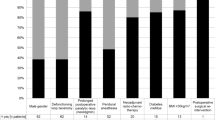Summary
Recent evidence has suggested that intraoperative administration of neostigmine to reverse the effects ofd-tubocurarine has contributed to anastomotic disruption or leakage of large-intestinal anastomoses. A retrospective study of 187 consecutive cases of large-intestinal anastomoses was made at the Ochsner Foundation Hospital. Thirtyeight patients received 2.5 mg of neostigmine and 1.2 mg of atropine sulfate by intravenous injection to reverse the effects ofd-tubocurarine. Of the 149 patients who received no such reversing drugs, there was clinical evidence of anastomotic leakage in three. None of the 38 patients who received neostigmine showed clinical evidence of anastomotic leak or disruption. On this basis, we see no reason to discontinue reversal of the effect ofd-tubocurarine with neostigmine and atropine.
Similar content being viewed by others
References
Aylett SO: Three hundred cases of diffuse ulcerative colitis treated by total colectomy and ileo-rectal anastomosis. Br Med J 1:1001, 1966
Bell CM, Lewis CB: Effects of neostigmine on integrity of ileorectal anastomoses. Br Med J 3:587, 1968
Chaudhary NA, Truelove SC: Human colonic motility: A comparative study of normal subjects, patients with ulcerative colitis, and patients with the irritable colon syndrome. II. The effect of prostigmin. Gastroenterology 40:18, 1961
Doughty AG, Wylie WD: Antidotes to “true” curarizing agents including a report on Ro2-3198 (Tensilon). Br J Anaesth 24:66, 1952
Dripps RD, Eckenhoff JE, Vandam LD: Introduction to Anesthesia: The Principles of Safe Practice. Ed. 3. Philadelphia, W. B. Saunders, 1967, 529 pp
Goligher JC, Graham NG, De Dombal FT: Anastomotic dehiscence after anterior resection of rectum and sigmoid. Br J Surg 57: 109, 1970
Goodman LS, Gilman A: The Pharmacological Basis of Therapeutics: A Textbook of Pharmacology, Toxicology, and Therapeutics for Physicians and Medical Students. Ed. 4. New York, Macmillan, 1970, 1794 pp
Griffith HR, Johnson GE: The use of curare in general anesthesia. Anesthesiology 3:418, 1942
Painter NS: The aetiology of diverticulosis of the colon with special reference to the action of certain drugs on the behaviour of the colon. Ann R Coll Surg Engl 34:98, 1964
Painter NS: The effect of neostigmine methyl sulphate on the human colon in health and in diverticulosis. Proc R Soc Med 60:219, 1967
Painter NS, Truelove SC: The intraluminal pressure patterns in diverticulosis of the colon. Part III. The effect of prostigmine. Gut 5:365, 1964
Author information
Authors and Affiliations
About this article
Cite this article
Cofer, T.W., Ray, J.E. & Gathright, J.B. Does neostigmine cause disruption of large-intestinal anastomoses?. Dis Colon Rectum 17, 235–237 (1974). https://doi.org/10.1007/BF02588107
Received:
Issue Date:
DOI: https://doi.org/10.1007/BF02588107




